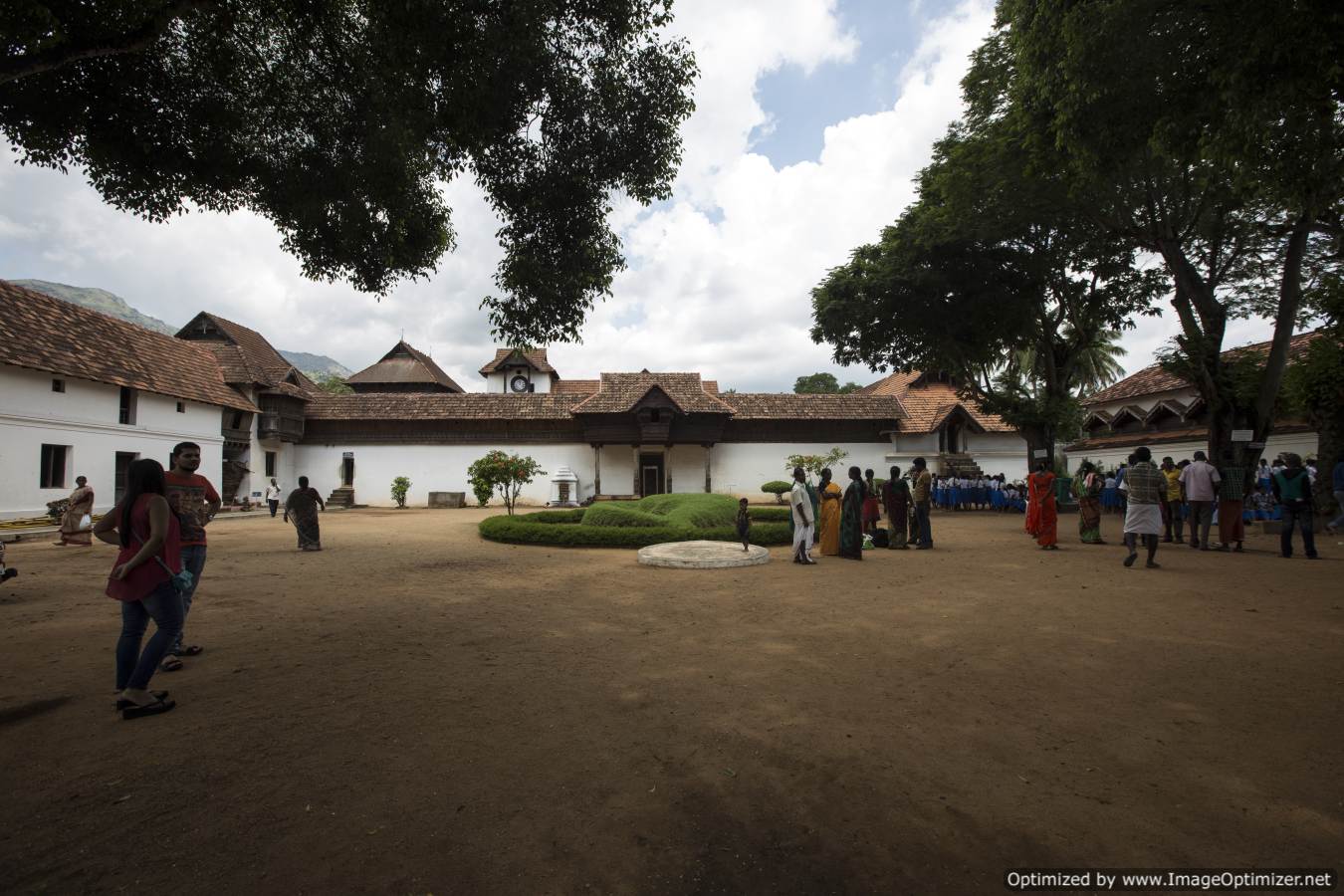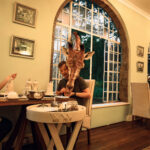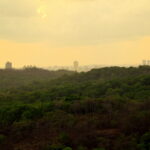Austere aesthetics, monochrome design, wooded architecture and minimalism in interior décor are some qualities we don’t usually associate with Indian palaces. However, Padmanabhapuram palace of Travancore, stands as a testimony to this minimalism. Infact this minimalism is hard to miss in keralite architecture, which is more wood based than bricked.
Our entry to the Padmanabhapuram palace was quiet and unnoticed. I looked at the wide swathes of latticed wood, polished wooden flooring looking more like inky pools with shadows of history, and floral designs that followed no pattern; and wondered how could such humble structures be destined to get vanished from the tourist map and get clubbed in the ‘off the track’ places league. The palace has long been forgotten, yet the glory of this beautiful building, built about 300 years ago, remains. The structures are as strong as they were when built and the entire tour is as enticing as any palace tour in the country. Padmanabhapuram palace is one of the finest existing examples of traditional Keralite Architecture, a fine specimen of traditional architecture of Malabar replete with teak, granite and stone all combining in a symphony of elegance and simplicity.

Padmanabhapuram palace is more wood based than brick
The Padmanabhapuram palace stands in the center of the village, with the Western Ghats forming a dramatic backdrop. On bright sunny days, the hills peep out from their hideaway, and the thatched roofs of the palace, the smiling hills and the floating clouds seem to become a part of the larger picture frame or rather a souvenir for the traveler. One eyeful and you realize nowhere else can you feel the fingers of time rustling the pages this history better than at Padmanabhapuram palace.
We enter through the Padippura (main gate) which retains the imposing appearance of the palace with its huge doors. And mind you, the structure’s simple and unpretentious exteriors defy its richly artistic interiors. It’s like stepping into a different world as you enter the palace. The wood work is unparalleled and artistic craftsmanship becomes a recurring theme as you wander through its 108 rooms. We crossed the main gate to reach the inner gabled entrance, the Poomukham, which was more traditional and ornamented than the main gate. The dainty wood carvings of horse riders on both sides of the entrance and the profusely embellished ceiling and pillars with a lotus medallion are eye-catching. In the center of the hall is a glittering bed made up of 7 pieces of granite,’ ona villu'(ceremonial bows with paintings of Padmanabhaswamy) with a brass oil lamp of a rider and horse hanging from the top. Beautifully ornamented, the lamp maintains its position seeming to defy all laws of gravity. This hall was used by the king to entertain special guests.
A narrow staircase leads you to the first floor or the mantrashala. The term ‘Mantra’ refers to administration of kingdom. It was at this hall that the king held discussions with his ministers and took important decisions. The wood carvings on the roof and beams and the black, polished floor proclaim the leap in craftsmanship. The intricacy of the floral designs and the dexterity in shaping the projections of the beams.

The wood carvings on the roof and beams and the black, polished floor proclaim the leap in craftsmanship in Padmanabhapuram palace
Adjacent to the Mantrashala, is the Oottupura, a double storied building with two dining halls, where over 2000 people were served meals on a daily basis. There are 13 Chinese jars in the hall, which were then used to preserve pickles.
Thaikkottaram or Mother’s palace
Mother’s Palace is the central locus of the palace around which all the rooms have been laid. Designed in traditional Kerala style around mid-16th century, it is characterized by an inner courtyard, Nalukettu (a quintessential part of Kerala architecture) with sloping roofs and intricately carved pillars on all sides. The wooden roof structure forms the most dominating part of the entire complex, with its wonderful juxtaposition, making it a playground of light, shadow & mass. The roof has been designed very creatively to make it both functional and aesthetic, following every rules of ancient building science of Vaastu. The overall effect of this mélange of science, art and craftsmanship is the cohesiveness that exists between structures, rendering them timeless.

King’s quarters
No doubt the grandest of all quarters in the palace, the king’s quarters form a part of the four storeyed building, which stands today as a testament to the technological progress of that era. A huge four poster bed made from 16 kinds of medicinal wood gifted by the Dutch, in the king’s bedroom, is the cynosure of all eyes. The sensitive handling of lights and shadows through jaalis, to create a wholesome, calming experience inside adds charm to the overall design of the room. The walls covered with murals depicting mythological and social scenes. The technique adopted is the use of light colour against a dark background or a dark tint against some light tone in the distance. The grace and beauty on the figures are mainly due to the art of line and the artist has given effective expression to his subject by simply modulating the line in various ways Belgian mirrors and Tanjore miniatures of Krishna adorn the chamber.

The huge bed is a cynosure for all eyes
The Padmanabhapuram palace is a masterpiece – with its intriguing play of volumes, lights, spatial layout and open spaces. The spaces move from public spaces in the periphery to the private ones in the core and this dexterity in planning is reflected in the variations in scale and proportions. A four storeyed building, unparallel murals adorning the walls, intricately carved wooden roofs and columns, the teasing play of lights and shadows, the wood screened chambers, mysterious corridors, intimate courtyards and comfortable interior spaces make this palace a timeless architectural marvel, reminding us of our innovation in planning, rich blend of architectural perfection and nature and our endless search of excellence.
To reach – Trivandrum is the most convenient place. Kerala Tourism (KTDC) daily operates conducted tours to Padmanabhapuram palace and other places. The palace can be a one day tour. Trivandrum offers endless options to stay.
The unmissable – A heritage musuem is accommodated in the Nalukettu building of Theekkottaram the most attractive part in the Padmanabhapuram palace complex. An archaeological museum with invaluable exhibits is located in the Southwest corner of the complex. The Sarasvathi temple opposite the Navarathri Mandapam with its wood screened chambers, used to accommodate the royal family is another visual treat.








Never read abt this palace before, amazing read
Thanks, as I said it is quite off-beat in Kerala
There are lots of wonderful places in Kerala. Please contact us in your next visit 🙂
Ohh sure Sego Tours
There are lots of wonderful places in Kerala. Please contact us in your next visit 🙂
[…] https://handofcolors.me/2016/06/26/grace-in-wood-padmanabhapuram-palace/ […]